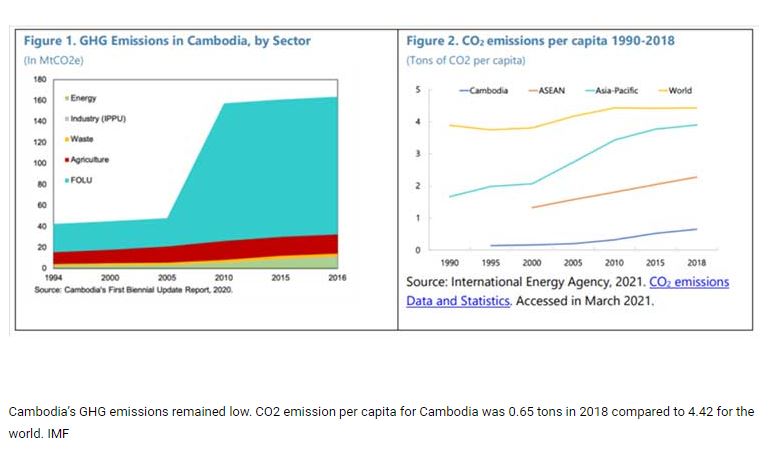Cambodia’s GHG emissions remain relatively low
The overall greenhouse gas emissions (GHG) in the country remain relatively low, according to the International Monetary Fund (IMF) assessment.
The GHG is projected to increase to 155 million tons of CO2 equivalent in 2030, growing from Cambodia government’s 2016 estimate by 24 percent
“Emissions under all Business-As-Usual (BAU) scenarios indicate a steady increase by 2030, with the highest emissions contributor from Cambodia’s Forest and Other Land Use (FOLU) sector (49 percent), followed by energy (22 percent) and agricultural sectors (18 percent),” the Executive Board of the International Monetary Fund (IMF), which concluded the Article IV consultation with Cambodia, said.
The IMF projects emissions growth for Cambodia under its BAU scenario at more than 30 percent from 2017 to 2030, mainly driven by fast economic growth.
According to the directors, Cambodia remains one of the most vulnerable countries to climate risks, while its greenhouse gas emissions remain relatively low.
“This summarizes the authorities’ climate targets and policy responses across both mitigation and adaptation, after setting out stylized facts about Cambodia’s greenhouse gas emissions and vulnerability to climate risks,” the directors pointed out.
Cambodia’s FOLU sector has traditionally been the major contributor to greenhouse gas (GHG) emissions, driven primarily by deforestation, they said, adding that GHG emissions have been steadily increasing over the last three decades, with a huge jump in GHG emissions by FOLU sector from 2010 onward.
“This was due to the differences in the observed loss of forest cover between 2010-2016 (579,280 ha/year in average) and 1994-2009 (132,733 ha/year in average) (National Council for Sustainable Development, 2020).
The experts also pointed out that GHG emissions were also accelerated by the agriculture and energy sectors. Agriculture is the second largest contributor, mainly through cultivation of rice. GHG emissions from agriculture increased at an annual average rate of about 2.5 percent between 1994 and 2016 (NCSD, 2020). Energy demand also increased significantly due to growth in the transport sector, due to urbanization and population growth (especially through migration to urban areas).
However, the directors noted that Cambodia’s GHG emissions remain relatively low. CO2 emission per capita for Cambodia was 0.65 tons in 2018 compared to 4.42 for the world, Asia-Pacific’s 3.89, and ASEAN’s 2.27.
“In terms of energy sources, oil accounted for 70 percent of CO2 emissions in 2018, with coal accounting for the remaining in the same year (International Energy Agency, 2021),” IMF indicated.
The report pointed out Cambodia’s commitment to achieving carbon neutrality by 2050.
“Cambodia submitted an updated NDC in 2020, with a commitment to reduce emissions by 42 percent by 2030 (RGC, 2020). In November 2021, at the UN Climate Change Conference (COP26), the Minister of Environment announced commitments to increase the share of clean energy without developing any new coal power plants and new hydropower dams along the Mekong River. In December 2021, the government submitted a Long-Term Strategy for Carbon Neutrality (LTS4CN), a pathway towards a country-wide carbon neutral economy by 2050, to the Secretariat of the United Nations Framework Convention on Climate Change (UNFCCC),” it pointed out.
Under Article IV of the IMF’s Articles of Agreement, the IMF holds bilateral discussions with members, usually every year. A staff team visits the country, collects economic and financial information, and discusses with officials the country’s economic developments and policies. On return to headquarters, the staff prepares a report, which forms the basis for discussion by the Executive Board.
At the conclusion of the discussion, the Managing Director, as Chairman of the Board, summarises the views of Executive Directors, and this summary is transmitted to the country’s authorities, an IMF release said.
Source: https://www.khmertimeskh.com/501206728/cambodias-ghg-emissions-remain-relatively-low/


 English
English




